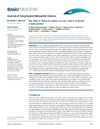Identificador persistente para citar o vincular este elemento:
https://accedacris.ulpgc.es/jspui/handle/10553/72348
| Campo DC | Valor | idioma |
|---|---|---|
| dc.contributor.author | Pérez Hernández, María Dolores | en_US |
| dc.contributor.author | Pickart, Robert S. | en_US |
| dc.contributor.author | Pavlov, Vladimir | en_US |
| dc.contributor.author | Våge, Kjetil | en_US |
| dc.contributor.author | Ingvaldsen, Randi | en_US |
| dc.contributor.author | Sundfjord, Arild | en_US |
| dc.contributor.author | Renner, Angelika H.H. | en_US |
| dc.contributor.author | Torres, Daniel J. | en_US |
| dc.contributor.author | Erofeeva, Svetlana Y. | en_US |
| dc.date.accessioned | 2020-05-13T12:37:44Z | - |
| dc.date.available | 2020-05-13T12:37:44Z | - |
| dc.date.issued | 2017 | en_US |
| dc.identifier.issn | 2169-9291 | en_US |
| dc.identifier.uri | https://accedacris.ulpgc.es/handle/10553/72348 | - |
| dc.description.abstract | Data from a shipboard hydrographic/velocity survey carried out in September 2013 of the region north of Svalbard in the Nansen Basin are analyzed to characterize the Atlantic Water (AW) boundary current as it flows eastward along the continental slope. Eight meridional transects across the current, spanning an alongstream distance of 180 km, allow for a detailed description of the current and the regional water masses. During the survey the winds were light and there was no pack-ice. The mean section reveals that the boundary current was O(40 km) wide, surface-intensified, with a maximum velocity of 20 cm/s. Its mean transport during the survey was 3.11 ± 0.33 Sv, of which 2.31 ± 0.29 Sv was AW. This suggests that the two branches of AW entering the Arctic Ocean via Fram Strait—the Yermak Plateau branch and the Svalbard branch—have largely combined into a single current by 30°E. At this location the boundary current meanders with a systematic change in its kinematic structure during offshore excursions. A potential vorticity analysis indicates that the flow is baroclinically unstable, consistent with previous observations of AW anticyclones offshore of the current as well as the presence of a near-field cyclone in this data set. Our survey indicates that only a small portion of the boundary current is diverted into the Kvitøya Trough (0.17 ± 0.08 Sv) and that the AW temperature/salinity signal is quickly eroded within the trough. | en_US |
| dc.language | eng | en_US |
| dc.relation.ispartof | Journal of geophysical research. Oceans | en_US |
| dc.source | Journal of Geophysical Research. Oceans [ISSN 2169-9291], v. 122, p. 2269–2290 | en_US |
| dc.subject | 2510 Oceanografía | en_US |
| dc.title | The Atlantic Water boundary current north of Svalbard in late summer | en_US |
| dc.type | info:eu-repo/semantics/article | en_US |
| dc.type | Article | en_US |
| dc.identifier.doi | 10.1002/2016JC012486 | en_US |
| dc.identifier.scopus | 2-s2.0-85017223336 | - |
| dc.contributor.orcid | #NODATA# | - |
| dc.contributor.orcid | #NODATA# | - |
| dc.contributor.orcid | #NODATA# | - |
| dc.contributor.orcid | #NODATA# | - |
| dc.contributor.orcid | #NODATA# | - |
| dc.contributor.orcid | #NODATA# | - |
| dc.contributor.orcid | #NODATA# | - |
| dc.contributor.orcid | #NODATA# | - |
| dc.contributor.orcid | #NODATA# | - |
| dc.description.lastpage | 2290 | en_US |
| dc.identifier.issue | 3 | - |
| dc.description.firstpage | 2269 | en_US |
| dc.relation.volume | 122 | en_US |
| dc.investigacion | Ciencias | en_US |
| dc.type2 | Artículo | en_US |
| dc.description.numberofpages | 21 | en_US |
| dc.utils.revision | Sí | en_US |
| dc.date.coverdate | Marzo 2017 | en_US |
| dc.identifier.ulpgc | Sí | es |
| dc.description.jcr | 2,711 | |
| dc.description.jcrq | Q1 | |
| item.fulltext | Con texto completo | - |
| item.grantfulltext | open | - |
| crisitem.author.dept | GIR IOCAG: Oceanografía Física | - |
| crisitem.author.dept | IU de Oceanografía y Cambio Global | - |
| crisitem.author.dept | Departamento de Física | - |
| crisitem.author.orcid | 0000-0001-7293-9584 | - |
| crisitem.author.parentorg | IU de Oceanografía y Cambio Global | - |
| crisitem.author.fullName | Pérez Hernández, María Dolores | - |
| Colección: | Artículos | |
Citas SCOPUSTM
44
actualizado el 08-jun-2025
Citas de WEB OF SCIENCETM
Citations
45
actualizado el 12-ene-2026
Visitas
42
actualizado el 10-ene-2026
Descargas
26
actualizado el 10-ene-2026
Google ScholarTM
Verifica
Altmetric
Comparte
Exporta metadatos
Los elementos en ULPGC accedaCRIS están protegidos por derechos de autor con todos los derechos reservados, a menos que se indique lo contrario.
